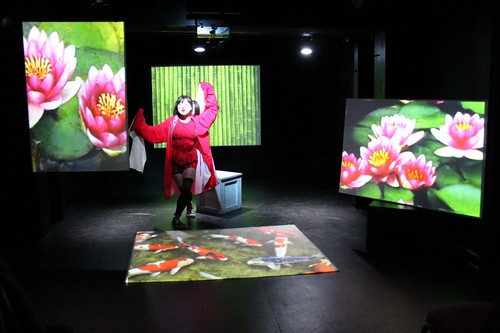Ming Peiffer — her face powdered white, to contrast her suggestive red kimono — leaps onto the stage at the Red Room, promising to teach Asians how to get famous. It’s easy to incite pity, she assures: just play up your immigrant background and describe how your family lived in poverty before coming to America. It’s because of this tragic past that you are entitled to make art — regardless of quality!
The farce should be obvious by now. An exposé of systematized racism against Asians in the theater industry, “The ABC’s Guide to Getting Famous” is part of a well-established tradition in American literature. It’s no “Invisible Man,” but this ingenious solo show cum documentary doesn’t claim to be. Instead, it uses projections of Ms Peiffer’s interviews with contemporary Asian actors and actresses to form a sociological foil to her blaring embodiment of the Asian stereotype.
These two viewpoints are particularly well-suited to disentangling the paradoxes and difficulties of fitting into a larger culture. Ms Peiffer, or ABC, says immerse yourself in Asian clubs, societies, meeting groups, while the interviewees say this is just as alienating as being the only Asian around; ABC says accentuate your eyes and audition for the kung fu master, the ninja, or the prostitute, while the actors on screen testify that they feel like caricatures daily, yet have a hard time finding work. Ms Peiffer, of half-Asian descent, offers herself as a demonstration in the end, since her other half is routinely neglected at auditions searching for stock characters.
One of the show’s targets is the media and its inability to create any Asian characters of substance, or rather its ability to create Asian characters entirely removed from reality. The actors’ humor is commendable yet dark as they recount, for example, the struggle to polish an “Asian accent” when their childhood was spent teaching their parents proper pronunciation. A Vietnamese actor (named Viet, no less) remembers how a Japanese actor got picked for a role instead of him because he “didn’t look Vietnamese enough.”
The piece offers no solutions to these baffling situations, since they are cultural in nature, and Asian actors have to acknowledge the injustices inherent to their career path. The end goal, however, is to change the broad culture so that Asians are seen and presented as they see themselves; as some actresses interviewed in the piece mention, of course they would love to be Lucy Liu, but what they really wish is for Lucy Liu not to be known as “the one Asian actress.”
This is where the piece reveals a message that isn’t fundamentally Asian, but applies to all minority cultures in the United States, since it is well known that not all groups of society are represented equally by the American media. Any fan of New York theater, large or small, and anyone who enjoys pondering knotty questions should see this show. Ms Peiffer argues, convincingly, for a more inclusive culture created by minorities working together, a vision which is much more American than the system she is struggling against.
“The ABC’s Guide to Getting Famous,” Sept. 27 at Red Room, 85 East Fourth Street (near Second Avenue); $18, horsetrade.info




